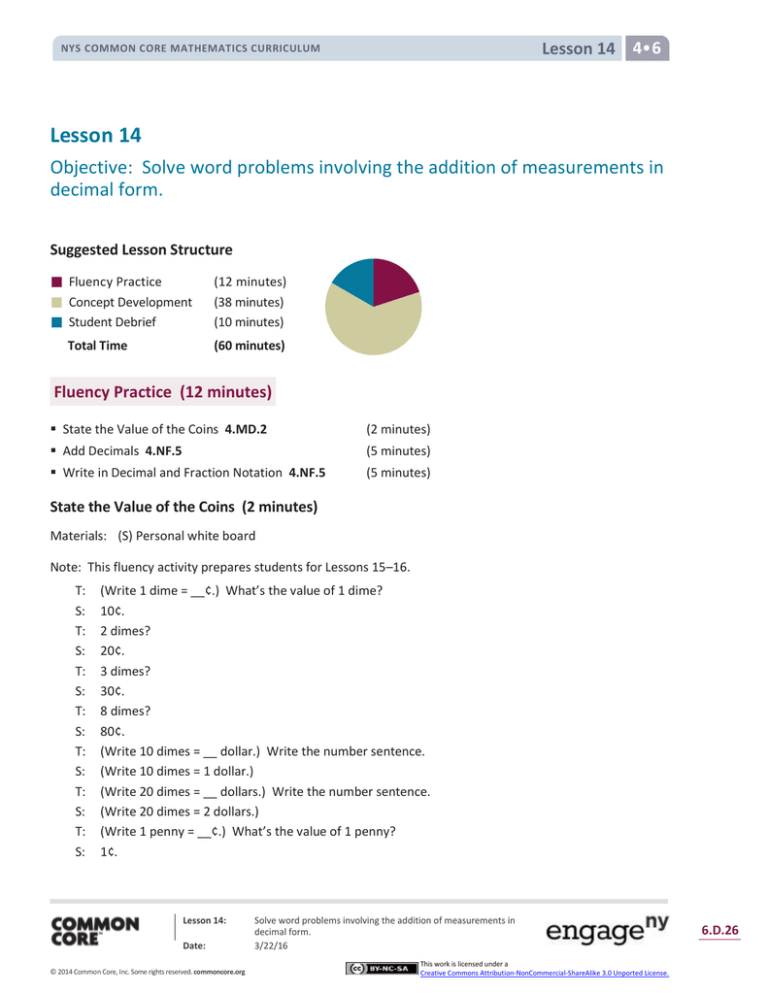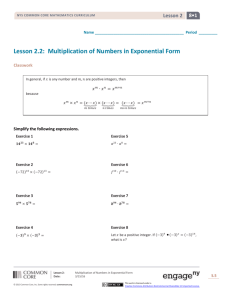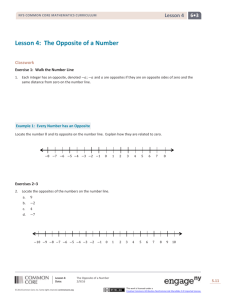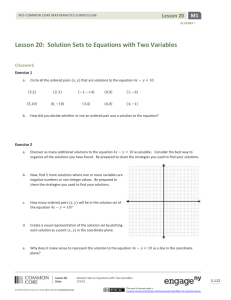
Lesson 14 4•6
NYS COMMON CORE MATHEMATICS CURRICULUM
Lesson 14
Objective: Solve word problems involving the addition of measurements in
decimal form.
Suggested Lesson Structure
Fluency Practice
Concept Development
Student Debrief
Total Time
(12 minutes)
(38 minutes)
(10 minutes)
(60 minutes)
Fluency Practice (12 minutes)
State the Value of the Coins 4.MD.2
(2 minutes)
Add Decimals 4.NF.5
(5 minutes)
Write in Decimal and Fraction Notation 4.NF.5
(5 minutes)
State the Value of the Coins (2 minutes)
Materials: (S) Personal white board
Note: This fluency activity prepares students for Lessons 15–16.
T:
S:
T:
S:
T:
S:
T:
S:
T:
S:
T:
S:
T:
S:
(Write 1 dime = __¢.) What’s the value of 1 dime?
10¢.
2 dimes?
20¢.
3 dimes?
30¢.
8 dimes?
80¢.
(Write 10 dimes = __ dollar.) Write the number sentence.
(Write 10 dimes = 1 dollar.)
(Write 20 dimes = __ dollars.) Write the number sentence.
(Write 20 dimes = 2 dollars.)
(Write 1 penny = __¢.) What’s the value of 1 penny?
1¢.
Lesson 14:
Date:
© 2014 Common Core, Inc. Some rights reserved. commoncore.org
Solve word problems involving the addition of measurements in
decimal form.
3/22/16
This work is licensed under a
Creative Commons Attribution-NonCommercial-ShareAlike 3.0 Unported License.
6.D.26
Lesson 14 4•6
NYS COMMON CORE MATHEMATICS CURRICULUM
T:
S:
T:
S:
T:
S:
T:
S:
2 pennies?
2¢.
3 pennies?
3¢.
9 pennies?
9¢.
(Write 7 pennies = __¢.) Write the number sentence.
(Write 7 pennies = 7¢.)
NOTES ON
MULTIPLE MEANS
OF ENGAGEMENT:
Add Decimals (5 minutes)
Materials: (S) Personal white board
English language learners and others
may benefit from a reminder, such as a
poster, personal dictionary, or word
wall, that defines and provides
examples of standard form, fraction
form, unit form, and decimal form.
Examples may provide clarity for the
Add Decimals fluency activity.
Note: This fluency activity reviews Lesson 13.
T:
S:
(Write 4 tens + 2 ones.) Say the addition sentence in
standard form.
40 + 2 = 42.
T:
(Write 10 + 100 = 100.) Write the number sentence.
S:
(Write 10 + 100 = 100.)
T:
(Write
S:
(Write 0.4 + 0.02 = 0.42.)
4
2
4
2
4
10
+
2
100
42
=
42
.)
100
Write the number sentence in decimal form.
Continue with the following possible sequence:
8
10
3
13
2
5
30
40
4
7
30
8
37
+ 100, 100 + 10, 10 + 100, 100 + 10, 10 + 100, and 10 + 100.
Write in Decimal and Fraction Notation (5 minutes)
Materials: (S) Personal white board
Note: This fluency activity reviews Lesson 12.
T:
S:
T:
S:
T:
S:
T:
(Write 36.79.) Say the number.
36 and 79 hundredths.
Write 36 and 79 hundredths in decimal expanded form without multiplication.
(Write 36.79 = 30 + 6 + 0.7 + 0.09.)
(Write 36.79 = (_ × 10) + (_ × 1) + (_ × 0.1) + (_ × 0.01).) Complete the number sentence.
(Write 36.79 = (3 × 10) + (6 × 1) + (7 × 0.1) + (9 × 0.01).)
Write 36 and 79 hundredths in fraction expanded form with multiplication.
S:
(Write 36 100 = (3 × 10) + (6 × 1) + (7 × 10) + (9 × 100).)
1
79
1
Continue with the following possible sequence: 34.09 and 734.80.
Lesson 14:
Date:
© 2014 Common Core, Inc. Some rights reserved. commoncore.org
Solve word problems involving the addition of measurements in
decimal form.
3/22/16
This work is licensed under a
Creative Commons Attribution-NonCommercial-ShareAlike 3.0 Unported License.
6.D.27
Lesson 14 4•6
NYS COMMON CORE MATHEMATICS CURRICULUM
Concept Development (38 minutes)
Materials: (S) Personal white board, Problem Set
Suggested Delivery of Instruction for Solving Lesson 14’s Word Problems
1. Model the problem.
Have two pairs of students model the problem at the board while the others work independently or in pairs
at their seats. Review the following questions before beginning the first problem:
Can you draw something?
What can you draw?
What conclusions can you make from your drawing?
As students work, circulate. Reiterate the questions above. After two minutes, have the two pairs of
students share only their labeled diagrams. For about one minute, have the demonstrating students receive
and respond to feedback and questions from their peers.
2. Calculate to solve and write a statement.
Give the students two minutes to finish work on that question,
sharing their work and thinking with a peer. All should then
write their equations and statements of the answer.
3. Assess the solution for reasonableness.
Give students one to two minutes to assess and explain the
reasonableness of their solutions.
Problem 1
Barrel A contains 2.7 liters of water. Barrel B contains 3.09 liters
of water. Together, how much water do the two barrels
contain?
NOTES ON
MULTIPLE MEANS
OF REPRESENTATION:
In today’s lesson, students apply their
skill with adding decimals by first
converting them to fraction form. The
first two problems are single-step
problems. Encourage the students to
use the RDW process because, in doing
so, they again realize that part–whole
relationships are the same whether the
parts are whole numbers, fractions, or
mixed numbers.
The first problem of the day starts at a simple level to give students the opportunity to simply apply their skill
with converting decimal numbers to fraction form to solve a word problem. Students solve this problem by
converting 2.7 liters and 3.09 liters to fractional form, converting tenths to hundredths, and adding the mixed
numbers. Remind students to convert their answers to decimal form when writing their statements.
Lesson 14:
Date:
© 2014 Common Core, Inc. Some rights reserved. commoncore.org
Solve word problems involving the addition of measurements in
decimal form.
3/22/16
This work is licensed under a
Creative Commons Attribution-NonCommercial-ShareAlike 3.0 Unported License.
6.D.28
Lesson 14 4•6
NYS COMMON CORE MATHEMATICS CURRICULUM
Problem 2
Alissa ran a distance of 15.8 kilometers one week and 17.34 kilometers the following week. How far did she
run in the two weeks?
Problem 2 invites various solution strategies because the sum of the fractions is greater than 1, and the whole
numbers are larger. In Solution A, students add like units and decompose by drawing a number bond to show
114
14
34
as 1 +
and then adding 32. In Solutions B and C, students use different methods of breaking apart
100
100
100
to add up to make 1.
Lesson 14:
Date:
© 2014 Common Core, Inc. Some rights reserved. commoncore.org
Solve word problems involving the addition of measurements in
decimal form.
3/22/16
This work is licensed under a
Creative Commons Attribution-NonCommercial-ShareAlike 3.0 Unported License.
6.D.29
Lesson 14 4•6
NYS COMMON CORE MATHEMATICS CURRICULUM
Problem 3
An apple orchard sold 140.5 kilograms of apples in the morning and 15.85 kilograms more apples in the
afternoon than in the morning. How many total kilograms of apples were sold that day?
This problem brings the additional complexity of two steps. Students solve this problem by converting 140.5
kilograms and 15.85 kilograms to fractional form, converting tenths to hundredths, and then adding the
mixed numbers. Remind students to convert their answers to decimal form and to include the labeled units
in their answers. Solution A shows solving for the number of kilograms sold in the afternoon and then solving
for the total number of kilograms sold in the day by adding the kilograms of apples from the morning with
those from the afternoon. In Solution B, the number of kilograms sold in the morning is multiplied by 2, and
then the additional kilograms sold in the afternoon are added.
Lesson 14:
Date:
© 2014 Common Core, Inc. Some rights reserved. commoncore.org
Solve word problems involving the addition of measurements in
decimal form.
3/22/16
This work is licensed under a
Creative Commons Attribution-NonCommercial-ShareAlike 3.0 Unported License.
6.D.30
Lesson 14 4•6
NYS COMMON CORE MATHEMATICS CURRICULUM
Problem 4
A team of three ran a relay race. The final runner’s time was the fastest, measuring 29.2 seconds. The middle
runner’s time was 1.89 seconds slower than the final runner’s. The starting runner’s time was 0.9 seconds
slower than the middle runner’s. What was the team’s total time for the race?
This problem involves two additional challenges. First, the students must realize that when a runner goes
slower, there is more time added on. Second, to find the starting runner’s time, students must add on the
9 tenths second to the middle runner’s time. Notice the difference in Solution A and B’s models. In Solution
A, the student finds the time of each individual runner, first adding 1.89 seconds to 29.2 seconds and then
adding 0.9 seconds to that sum to find the time of the starting runner. On the other hand, Solution B shows
how a student solves by thinking of the starting runner in relationship to the final runner. As a result, she is
89
89
9
able to discern the 3 units of 29.2 seconds, multiplies 29.2 by 3, adds 1 100 + 1 100 + 10, and adds the two sums
together.
Lesson 14:
Date:
© 2014 Common Core, Inc. Some rights reserved. commoncore.org
Solve word problems involving the addition of measurements in
decimal form.
3/22/16
This work is licensed under a
Creative Commons Attribution-NonCommercial-ShareAlike 3.0 Unported License.
6.D.31
Lesson 14 4•6
NYS COMMON CORE MATHEMATICS CURRICULUM
Student Debrief (10 minutes)
Lesson Objective: Solve word problems involving the
addition of measurements in decimal form.
The Student Debrief is intended to invite reflection and
active processing of the total lesson experience.
Invite students to review their solutions for the Problem
Set. They should check work by comparing answers with a
partner before going over answers as a class. Look for
misconceptions or misunderstandings that can be
addressed in the Debrief. Guide students in a
conversation to debrief the Problem Set and process the
lesson.
Any combination of the questions below may be used to
lead the discussion.
What was the added complexity of Problem 3?
What about Problem 4?
Explain the strategies that you used to solve
Problems 3 and 4.
Exit Ticket (3 minutes)
After the Student Debrief, instruct students to complete
the Exit Ticket. A review of their work will help with
assessing students’ understanding of the concepts that
were presented in today’s lesson and planning more
effectively for future lessons. The questions may be read
aloud to the students.
Lesson 14:
Date:
© 2014 Common Core, Inc. Some rights reserved. commoncore.org
Solve word problems involving the addition of measurements in
decimal form.
3/22/16
This work is licensed under a
Creative Commons Attribution-NonCommercial-ShareAlike 3.0 Unported License.
6.D.32
NYS COMMON CORE MATHEMATICS CURRICULUM
Name
Lesson 14 Problem Set 4•6
Date
1. Barrel A contains 2.7 liters of water. Barrel B contains 3.09 liters of water. Together, how much water do
the two barrels contain?
2. Alissa ran a distance of 15.8 kilometers one week and 17.34 kilometers the following week. How far did
she run in the two weeks?
Lesson 14:
Date:
© 2014 Common Core, Inc. Some rights reserved. commoncore.org
Solve word problems involving the addition of measurements in
decimal form.
3/22/16
This work is licensed under a
Creative Commons Attribution-NonCommercial-ShareAlike 3.0 Unported License.
6.D.33
NYS COMMON CORE MATHEMATICS CURRICULUM
Lesson 14 Problem Set 4•6
3. An apple orchard sold 140.5 kilograms of apples in the morning and 15.85 kilograms more apples in the
afternoon than in the morning. How many total kilograms of apples were sold that day?
4. A team of three ran a relay race. The final runner’s time was the fastest, measuring 29.2 seconds. The
middle runner’s time was 1.89 seconds slower than the final runner’s. The starting runner’s time was
0.9 seconds slower than the middle runner’s. What was the team’s total time for the race?
Lesson 14:
Date:
© 2014 Common Core, Inc. Some rights reserved. commoncore.org
Solve word problems involving the addition of measurements in
decimal form.
3/22/16
This work is licensed under a
Creative Commons Attribution-NonCommercial-ShareAlike 3.0 Unported License.
6.D.34
NYS COMMON CORE MATHEMATICS CURRICULUM
Name
Lesson 14 Exit Ticket 4•6
Date
Elise ran 6.43 kilometers on Saturday and 5.6 kilometers on Sunday. How many total kilometers did she run
on Saturday and Sunday?
Lesson 14:
Date:
© 2014 Common Core, Inc. Some rights reserved. commoncore.org
Solve word problems involving the addition of measurements in
decimal form.
3/22/16
This work is licensed under a
Creative Commons Attribution-NonCommercial-ShareAlike 3.0 Unported License.
6.D.35
NYS COMMON CORE MATHEMATICS CURRICULUM
Name
Lesson 14 Homework 4•6
Date
1. The snowfall in Year 1 was 2.03 meters. The snowfall in Year 2 was 1.6 meters. How many total meters
of snow fell in Years 1 and 2?
2. A deli sliced 22.6 kilograms of roast beef one week and 13.54 kilograms the next. How many total
kilograms of roast beef did the deli slice in the two weeks?
Lesson 14:
Date:
© 2014 Common Core, Inc. Some rights reserved. commoncore.org
Solve word problems involving the addition of measurements in
decimal form.
3/22/16
This work is licensed under a
Creative Commons Attribution-NonCommercial-ShareAlike 3.0 Unported License.
6.D.36
NYS COMMON CORE MATHEMATICS CURRICULUM
Lesson 14 Homework 4•6
3. The school cafeteria served 125.6 liters of milk on Monday and 5.34 more liters of milk on Tuesday than
on Monday. How many total liters of milk were served on Monday and Tuesday?
4. Max, Maria, and Armen were a team in a relay race. Max ran his part in 17.3 seconds. Maria was 0.7
seconds slower than Max. Armen was 1.5 seconds slower than Maria. What was the total time for the
team?
Lesson 14:
Date:
© 2014 Common Core, Inc. Some rights reserved. commoncore.org
Solve word problems involving the addition of measurements in
decimal form.
3/22/16
This work is licensed under a
Creative Commons Attribution-NonCommercial-ShareAlike 3.0 Unported License.
6.D.37








